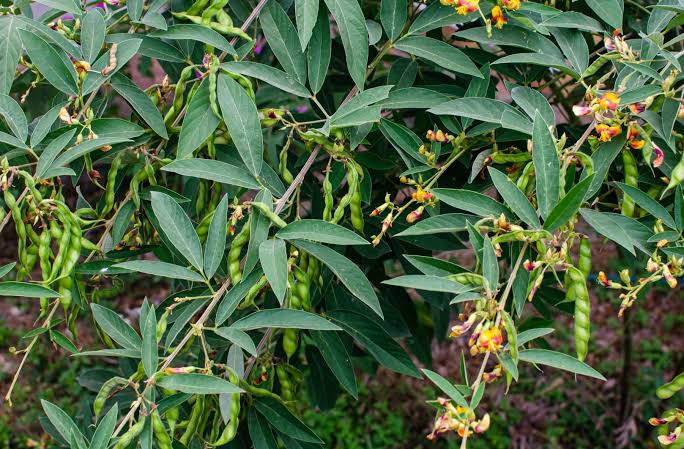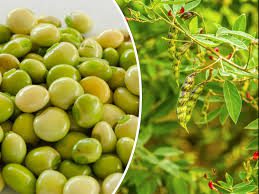Pigeon pea, also known as Cajanus cajan, is a remarkable legume that holds a special place in agriculture and nutrition. This humble pea, originating from the Indian subcontinent, has spread its influence across various continents, contributing significantly to both farming practices and human diets.
In the field of agriculture, pigeon pea stands out as a resilient and drought-tolerant crop. Farmers appreciate its ability to thrive in diverse climatic conditions, making it a valuable asset in regions where water scarcity is a common challenge. The plant’s deep root system enables it to extract moisture from the soil efficiently, showcasing its adaptability to arid environments.
Beyond its agricultural prowess, pigeon pea plays a pivotal role in enhancing soil fertility. Its nitrogen-fixing capabilities contribute to soil enrichment, benefiting not only the current crop but also improving the conditions for subsequent plantings. This unique characteristic makes pigeon pea a popular choice in crop rotation strategies, fostering sustainable and eco-friendly farming practices.
On the nutritional front, pigeon pea packs a powerful punch. Rich in protein, fiber, and essential nutrients, it emerges as a wholesome addition to diets worldwide. Its protein content is particularly noteworthy, addressing the dietary needs of communities where meat sources might be limited or less accessible. This makes pigeon pea a valuable ally in combating malnutrition and promoting balanced nutrition.
In culinary realms, pigeon pea proves its versatility. From hearty stews and soups to flavorful curries, this legume adds depth and substance to a wide array of dishes. Its mild taste allows it to harmonize with various spices and seasonings, making it a staple ingredient in many traditional cuisines. Additionally, pigeon pea flour finds use in creating nutritious flatbreads, expanding its culinary applications.
The economic significance of pigeon pea should not be overlooked. As a cash crop, it provides livelihoods for countless farmers, especially in developing regions. The demand for pigeon pea in international markets underscores its global impact, contributing to trade and economic growth.
However, the unassuming pigeon pea transcends its modest appearance, emerging as a resilient crop, a nutritional powerhouse, and an economic driver. Its adaptability, nutritional value, and culinary versatility make it a valuable asset in the quest for sustainable agriculture and global food security.
The cultural significance of pigeon pea adds another layer to its story. In many societies, this legume is more than just a crop; it’s woven into the fabric of traditions and customs. From celebratory feasts to daily meals, pigeon pea finds its way onto the plates of families, symbolizing sustenance and community.
One remarkable aspect of pigeon pea is its role in agroforestry systems. Integrated into farming practices, pigeon pea trees contribute to agroecological balance by providing shade, preventing soil erosion, and supporting biodiversity. This holistic approach to cultivation showcases the symbiotic relationship between agriculture and the environment, promoting long-term sustainability.
Pigeon pea’s resilience against pests and diseases further enhances its appeal for farmers practicing organic and sustainable agriculture. With reduced reliance on chemical inputs, pigeon pea aligns with eco-friendly farming practices, promoting a healthier balance between agricultural productivity and environmental preservation.
In the realm of research and development, scientists continue to explore the potential of pigeon pea in addressing global challenges. Whether it’s breeding varieties with enhanced nutritional profiles or developing pest-resistant strains, ongoing efforts aim to unlock the full potential of this unassuming legume in meeting the evolving needs of a growing population.
The story of pigeon pea is one of adaptability, nourishment, and interconnectedness. As it continues to grace fields, tables, and cultural traditions around the world, its journey reflects the resilience of nature, the ingenuity of agriculture, and the shared pursuit of a sustainable and nourished planet.
Read Also: Guide to Proper Management of Growing and Finishing Pigs
Growing and Care Guide of Pigeon Pea

Growing and caring for pigeon peas can be a rewarding endeavor, whether you’re a seasoned farmer or a novice gardener. Here’s a simple guide to help you cultivate and nurture these versatile legumes:
1. Planting:
Choose the Right Location: Pigeon peas thrive in well-drained soil and full sunlight. Select a location with good sunlight exposure for at least 6-8 hours a day.
Sowing Seeds: Plant pigeon pea seeds directly into the soil or in pots. Sow the seeds at a depth of about 1-2 inches, with a spacing of 3-4 feet between plants.
Watering: Ensure consistent moisture during the germination period. Once established, pigeon peas are relatively drought-tolerant, but regular watering is essential during dry spells.
2. Cultivation:
Soil Requirements: Pigeon peas prefer sandy or loamy soil with a slightly acidic to neutral pH. Good drainage is crucial to prevent waterlogging.
Fertilization: While pigeon peas are nitrogen-fixing, a light application of balanced fertilizer at planting can provide a nutrient boost. Avoid excessive nitrogen as it may hinder nitrogen-fixing bacteria.
Weeding: Keep the area around the plants weed-free, especially in the early stages. Weeds can compete for nutrients and water.
3. Maintenance:
Support for Tall Varieties: Some varieties of pigeon peas can grow quite tall. Provide support, such as stakes, to prevent the plants from falling over during heavy winds or rain.
Pruning: Regular pruning can help control the size of the plant and improve air circulation, reducing the risk of diseases.
4. Harvesting:
Timing: Pigeon peas typically mature in about 4-6 months. Harvest the pods when they are mature but still green. Overly mature pods may become dry and lose flavor.
Method: Harvest the pods by hand-picking or cutting the stems. Use gloves as some varieties have thorny pods.
5. Pest and Disease Management:
Watch for Pests: Keep an eye out for pests like aphids and pod borers. Insecticidal soap or neem oil can be used for organic pest control.
Disease Prevention: Practice crop rotation to reduce the risk of soil-borne diseases. Proper spacing and pruning also aid in disease prevention.
6. Utilization:
Storage: Store harvested pigeon peas in a cool, dry place. Dried peas can be stored for an extended period.
Cooking and Processing: Pigeon peas can be used in various culinary applications. From soups and stews to curries and dals, their versatility makes them a valuable addition to the kitchen.
By following these guidelines, you can cultivate healthy pigeon pea plants and enjoy the benefits of this resilient and nutritious legume. Happy gardening!
Uses of Pigeon Pea
Pigeon peas boast a wide range of uses, making them a versatile and valuable ingredient in various aspects of life. Here are some notable applications:
1. Culinary Uses:
Cooking Staples: Pigeon peas are a staple in many cuisines, especially in South Asia, Africa, and Latin America. They are used to prepare soups, stews, and curries.
Dals and Lentils: Pigeon peas, when split, are commonly used in the preparation of dals (lentil soups), providing a rich source of protein.
Flatbreads: Pigeon pea flour is utilized in making nutritious flatbreads, adding a distinctive flavor to the final product.
2. Nutritional Value:
Protein Source: Pigeon peas are a valuable source of plant-based protein, making them essential in vegetarian and vegan diets.
Dietary Fiber: Rich in dietary fiber, pigeon peas contribute to digestive health and can help in maintaining a healthy weight.
3. Agricultural and Environmental Uses:
Nitrogen Fixation: Pigeon peas are known for their nitrogen-fixing ability, enhancing soil fertility. This makes them a valuable component in crop rotation systems.
Agroforestry: Pigeon pea trees are utilized in agroforestry systems, providing shade, preventing soil erosion, and promoting biodiversity.
4. Economic Importance:
Cash Crop: Pigeon peas serve as a significant cash crop, providing income for farmers and contributing to the agricultural economy.
International Trade: Due to its demand in various global markets, pigeon peas play a role in international trade, further bolstering economic growth.
5. Traditional and Cultural Significance:
Cultural Celebrations: Pigeon peas are often featured in traditional dishes prepared during festivals and celebrations, symbolizing abundance and prosperity.
Culinary Heritage: In many cultures, the preparation and consumption of pigeon peas are deeply rooted in culinary traditions, passing down from one generation to another.
6. Livestock Feed:
Animal Nutrition: Pigeon pea plants, along with their by-products, can be used as fodder for livestock, contributing to their nutritional needs.
7. Green Manure:
Soil Enrichment: When used as a cover crop or green manure, pigeon peas contribute to soil enrichment by adding organic matter and improving soil structure.
In essence, the uses of pigeon peas extend far beyond the culinary realm, encompassing agriculture, nutrition, culture, and economics. Their adaptability and contributions to various aspects of life make them a valuable and multifaceted resource.
Read Also: Guide to Proper Management of Weaners
Economic Importance of Pigeon Pea

The economic importance of pigeon peas is substantial, playing a pivotal role in the agricultural sector and contributing significantly to the economies of many regions. Here are key aspects of their economic significance:
1. Cash Crop Revenue: Pigeon peas are cultivated as a cash crop, providing a crucial source of income for farmers. The sale of pigeon peas in local and international markets contributes directly to the financial well-being of agricultural communities.
2. Global Trade: Pigeon peas have a strong presence in international trade. They are exported to various countries, meeting the demand for this versatile legume in diverse culinary traditions around the world. This trade fosters economic exchanges and can lead to increased foreign exchange earnings for exporting countries.
3. Market Demand: The increasing recognition of the nutritional value of pigeon peas has driven demand in both domestic and international markets. As a result, farmers can benefit from favorable market conditions, receiving competitive prices for their produce.
4. Diversification of Income: Growing pigeon peas allows farmers to diversify their agricultural activities. This diversification not only contributes to income stability but also mitigates risks associated with relying solely on a single crop.
5. Employment Generation: The cultivation and processing of pigeon peas create employment opportunities along the entire value chain. From planting and harvesting to processing and marketing, various stages of pigeon pea production involve a workforce, supporting livelihoods in rural areas.
6. Sustainable Agriculture: Pigeon peas play a role in sustainable agriculture due to their nitrogen-fixing capabilities. By improving soil fertility, they contribute to the overall health of agricultural ecosystems, reducing the need for synthetic fertilizers and enhancing long-term productivity.
7. Research and Development Investment: Ongoing research and development in the field of pigeon pea cultivation contribute to improved crop varieties, disease resistance, and increased yields. Investments in agricultural innovation can lead to enhanced productivity and economic gains for farmers.
8. Food Security: Pigeon peas contribute to food security by providing a nutrient-rich source of protein and other essential nutrients. Access to this legume helps address nutritional deficiencies, especially in regions where meat sources are limited.
9. Rural Development: The economic importance of pigeon peas extends to rural development. As a viable agricultural enterprise, pigeon pea cultivation can stimulate infrastructure development, education, and healthcare services in rural communities.
In summary, the economic importance of pigeon peas is multifaceted, ranging from direct income generation for farmers to broader contributions in international trade, sustainable agriculture, and rural development. The versatility and adaptability of pigeon peas make them a valuable asset in fostering economic growth and resilience in agricultural economies.
Read Also: Microbiological Examination of Food

